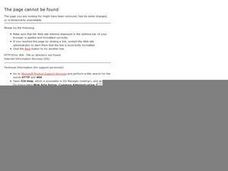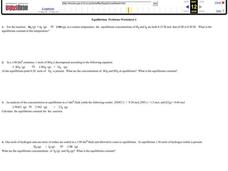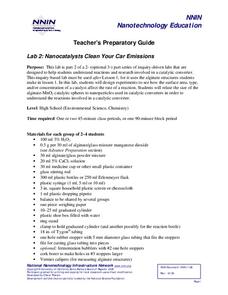Pingry School
The Alchemist's Dream – Copper into "Gold"
Many scientists attempted alchemy for hundreds of years before a full understanding of metals became clear. Scholars take a penny and, through two different chemical reactions, make it appear to turn into silver and later gold. They...
Curated OER
The "Laws" and Principles of Chemical Reactions
In this chemical reaction principles worksheet, students read about definite proportions and the law of conservation of mass. Students read about how to balance a chemical equation. Then students complete 20 fill in the blank, 2 short...
Curated OER
Experiment on Measuring Reaction Rates
High schoolers investigate the rate of a chemical reaction. In this rate of reactions lesson plan, students use an electronic balance to measure the change in mass of a chemical reaction between hydrochloric acid and calcium carbonate....
Curated OER
Chemical Composition of American Coins
High schoolers investigate the chemical composition of pennies dated 1983 or later. In this chemical composition of American coins lesson plan, students scratch the surface of the penny to expose the zinc core. They put the penny in...
Curated OER
More Thermochemistry Problems
This two-page assignment covers basic thermochemistry concepts. Chemistry learners identify exothermic and endothermic processes, explain a phase change graph, and draw an energy level diagram. There are no problems to solve, just...
Science Geek
Balancing Chemical Equations
Balancing equations means conserving mass; use the presentation to help learners practice this concept. The resource includes 56 equations for your class to practice balancing. Scholars focus on one reaction type at a time. Groups of...
Curated OER
Conserving Chemical Resources
Young scholars balance chemical equations and solve for gram to mole ratios.
Curated OER
Equilibrium Problems
In this equilibrium worksheet, students determine the equilibrium concentrations and the equilibrium constant for the given reactions. This worksheet has 5 problems to solve.
Curated OER
Acids and Bases
In this acids and bases worksheet, students review the characteristics of acids and bases, pK values, factors that change the rate of reactions, and catalysts. This worksheet has 17 multiple choice questions.
Curated OER
Chemical Formulas
Here is an interesting lesson which invites learners to focus on understanding and interpreting the symbols used in writing and communicating information about chemical elements, compounds, and equations. The hope is that this knowledge...
Curated OER
Chemistry Worksheet 6
In this chemistry worksheet, students calculate specific changes that take place with different chemical reactions. Students indicate whether the reactions are endothermic or exothermic and spontaneous or nonspontaneous.
Curated OER
Hot Gas Or Cold Gas Lab
Students engage in a lab project to study chemical reactions. They use guided questions to help facilitate the lab experience and come to the correct outcomes. The lesson does not contain a true understandable objective. The lesson could...
Curated OER
Chemical Equilibrium Worksheet #1
In this chemical equilibrium worksheet, students list 4 ways to increase the concentration of the product. They answer 9 multiple choice questions about equilibrium reactions.
Curated OER
Reaction Reversibility
In this reaction reversibility instructional activity, high schoolers find the equilibrium equation for a reaction of two gases and plot their concentrations over time. They answer 12 questions about the chemical reaction.
Curated OER
An Experiment in Alchemy: Copper to Silver to Gold
How exciting would it be for your chemistry class to produce their own "gold"? This experiment allows pupils to witness the chemical reaction of copper pennies as they react with zinc and sodium hydroxide to produce "gold" tokens. It is...
National Nanotechnology Infrastructure Network
Lab 2: Nanocatalysts Clean Your Car Emissions
Surface area certainly surfaces as a variable for chemical reaction rates. Scholars perform an experiment to discover how the size of catalysts affect the rate of a chemical reaction. They record their results in tables and graphs to...
National Institute of Open Schooling
Adsorption and Catalysis
Adsorption, not absorption, is when atoms stick to the surface of an object, like water sticking to a grain of sand. An informative lesson delves into adsorption, teaching physical and chemisorption and the factors that affect them....
Curated OER
Tie Dye
Students practice writing research proposals to test the color fastness of a dye once it has been exposed to a t-shirt. Each proposal needs details of experimental design, length of treatment, and means of cleaning the shirt. All...
Curated OER
Moles and Stoichiometry Practice Problems
Five practice stoichiometry problems plus their answers fill this chemistry worksheet. Because the answers are spread across the bottom of the page, this would best be used as your class is just learning how to perform mole and mass...
Curated OER
Types of Chemical Reactions
In this chemical reactions worksheet, students fill in 12 blanks, determine if 5 statements are true or false, match 4 types of reactions with their description and solve 2 problems related to balancing equations and chemical reactions.
Curated OER
Chemical Reactions
For this chemical reactions worksheet, students determine the order of a reaction based on experimental results. This worksheet has 5 problems to solve.
Curated OER
Chemical Reactions
In this chemical reactions worksheet, students write chemical equations, draw and label isomers, and predict products of chemical reactions. This worksheet has 5 drawings, 1 short answer, and 7 fill in the blank questions.
Curated OER
Chemical Reactions at Equilibrium
In this chemical reactions learning exercise, students calculate the value for the equilibrium constant and the equilibrium concentrations for specific reactions. This learning exercise has 6 word problems.
Curated OER
Chemical Reactions
In this chemical reactions worksheet, students write the structures or names from molecular formulas. Then students predict the products from reactions given. This worksheet has 9 fill in the blank questions.

























